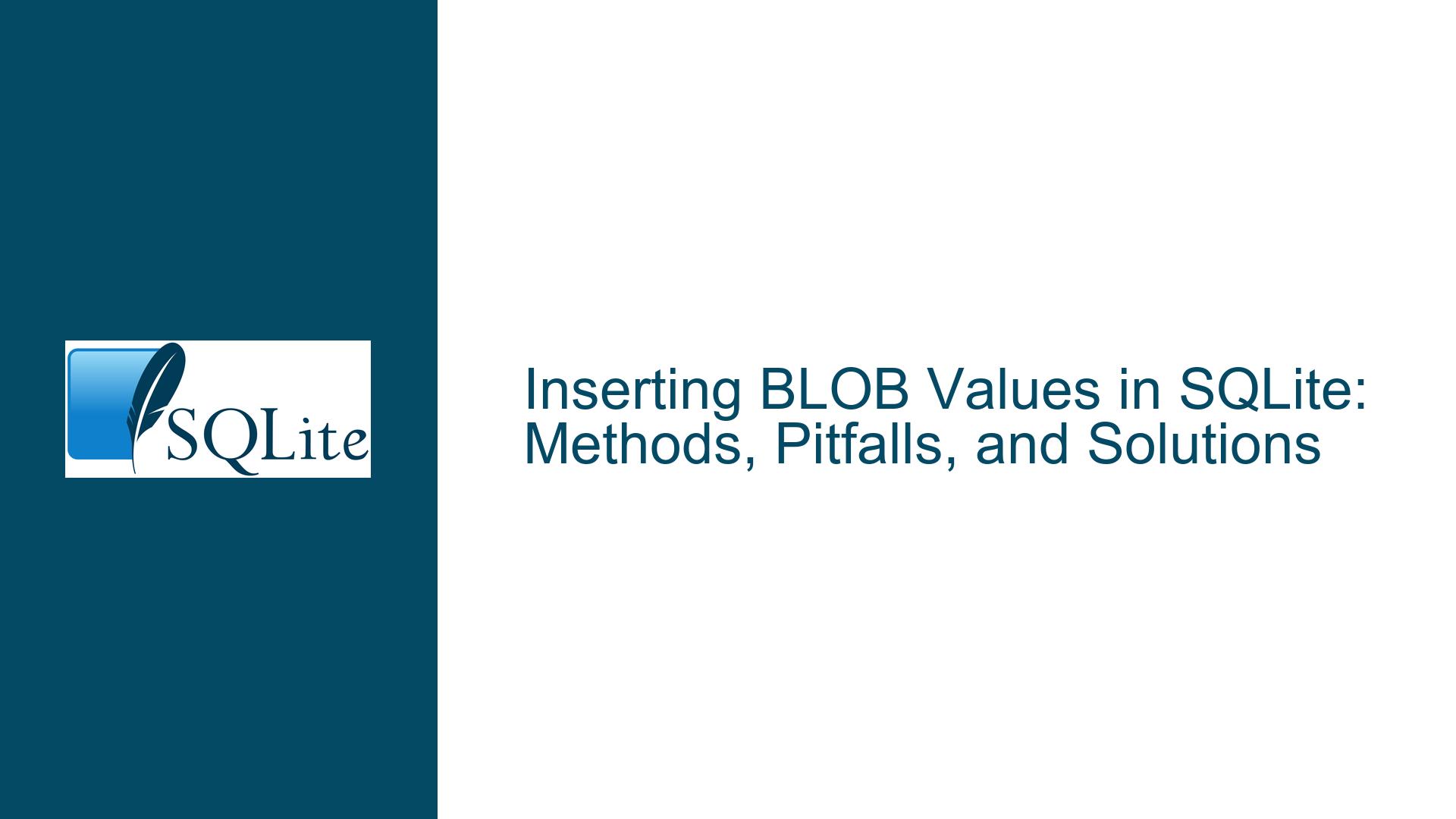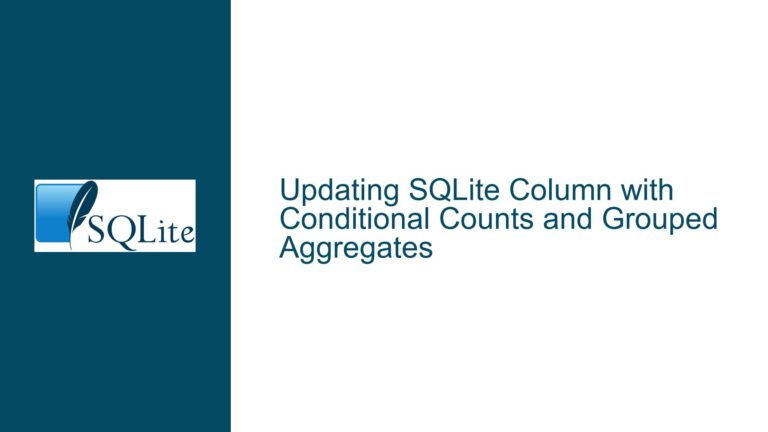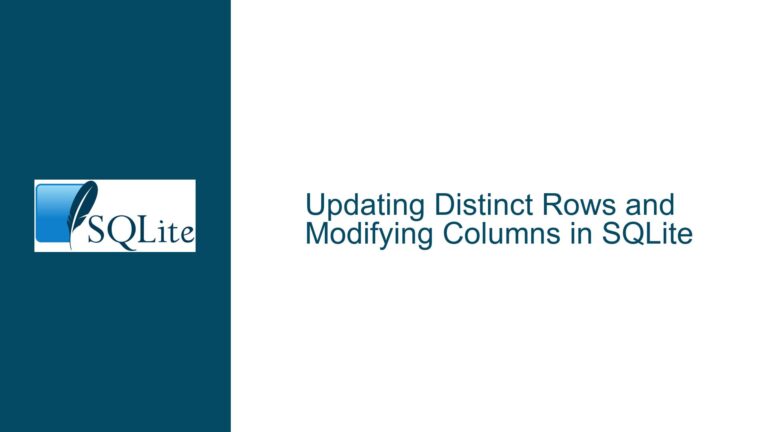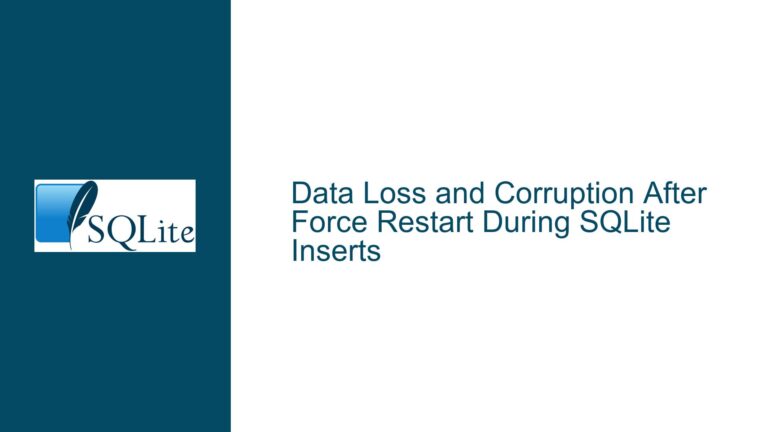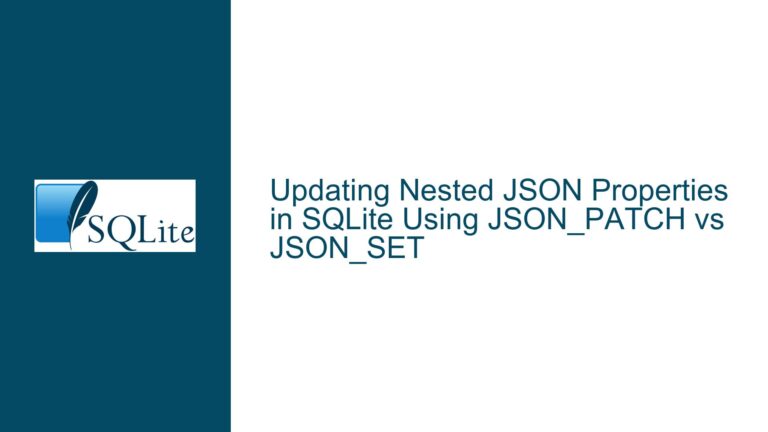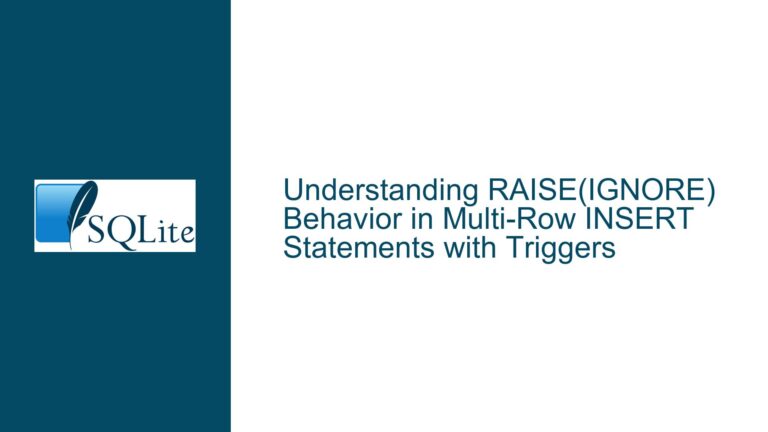Inserting BLOB Values in SQLite: Methods, Pitfalls, and Solutions
Issue Overview: Inserting BLOB Values and Verifying Storage Class
The core challenge involves inserting binary large object (BLOB) values into a SQLite database column and ensuring that the storage class of the inserted value is correctly recognized as BLOB when queried using the typeof() function. SQLite employs a dynamic type system where the storage class of a value is determined by the value itself rather than the column’s declared type affinity. This creates scenarios where developers must explicitly format values to enforce their interpretation as BLOBs.
Consider a table tblBLOB created without explicit column type specification:
CREATE TABLE IF NOT EXISTS tblBLOB (MyColumn);
The column MyColumn has a type affinity of BLOB due to SQLite’s rules for determining column affinity. However, inserting values into this column without proper formatting may result in the values being stored as TEXT, INTEGER, or other storage classes. For example:
INSERT INTO tblBLOB VALUES ('0100'); -- Stored as TEXT
INSERT INTO tblBLOB VALUES (0100); -- Stored as INTEGER
To ensure the storage class is BLOB, the inserted value must adhere to specific syntax or functions that force SQLite to treat it as binary data. The problem arises when developers assume that a column with BLOB affinity automatically coerces values into BLOBs, which is not the case. The typeof() function will return blob only if the value itself is explicitly formatted or cast as a BLOB during insertion.
Possible Causes: Misinterpretation of Values and Column Affinity
The primary causes of incorrect BLOB storage stem from misunderstandings about SQLite’s type affinity rules, improper value formatting, and reliance on implicit type conversions. Below are detailed explanations of these root issues:
Ambiguous Value Representation
SQLite interprets values based on their syntax. A string literal like'0100'is treated asTEXT, while an unquoted numeric value like0100is treated asINTEGER. Without explicit formatting (e.g., hexadecimal notation), SQLite has no mechanism to infer that a value should be stored as a BLOB.Overreliance on Column Affinity
Columns withBLOBaffinity do not enforce a specific storage class. They merely influence the preferred type for storage if the value can be converted without data loss. For instance, insertingx'0100'into a column withINTEGERaffinity will still store the value asBLOBbecause the hexadecimal literal explicitly defines binary data that cannot be converted to an integer without altering its meaning.Incorrect Use of Casting and Functions
UsingCAST(value AS BLOB)can convert some value types to BLOBs, but this approach has caveats. For example, casting aTEXTvalue toBLOBconverts the string to its UTF-8 byte sequence, which may not match the intended binary representation. Similarly, functions likereadfile()must be used with valid file paths and proper escaping in the SQLite command-line interface (CLI).Unfamiliarity with SQLite CLI Features
The SQLite CLI provides utility functions likereadfile()for reading file contents as BLOBs, but developers often overlook these features or misuse them (e.g., failing to quote file paths or using incorrect syntax for hexadecimal literals).
Troubleshooting Steps, Solutions & Fixes: Ensuring Correct BLOB Storage
1. Using Hexadecimal Literals for Small BLOBs
Hexadecimal literals are the most straightforward way to insert small BLOB values. Prefix the literal with x or X and enclose the hex digits in single quotes:
INSERT INTO tblBLOB VALUES (x'0100'); -- Correct: BLOB
INSERT INTO tblBLOB VALUES ('0100'); -- Incorrect: TEXT
Pitfalls:
- Omitting the
xprefix results in aTEXTvalue. - Using invalid hex characters (e.g.,
x'GH') causes errors.
2. Leveraging readfile() for File-Based BLOBs
The SQLite CLI’s readfile() function reads a file’s contents as a BLOB:
INSERT INTO tblBLOB VALUES (readfile('image.png'));
Requirements:
- The file must exist at the specified path.
- Absolute paths or correct relative paths must be used.
Example Error:
INSERT INTO tblBLOB VALUES (readfile(image.png)); -- Missing quotes around path
Error: no such column: image.png
3. Explicit Casting with CAST(value AS BLOB)
Use CAST to convert compatible types to BLOBs:
INSERT INTO tblBLOB VALUES (CAST('text' AS BLOB)); -- BLOB (UTF-8 bytes of 'text')
INSERT INTO tblBLOB VALUES (CAST(123 AS BLOB)); -- BLOB (bytes of integer 123)
Limitations:
- Casting from
TEXTconverts the string to its UTF-8 byte sequence, which may not match arbitrary binary data. - Casting from
INTEGERorREALconverts the number to its binary representation in SQLite’s internal encoding.
4. Parameter Binding in Programming Environments
When using programming languages (e.g., Python, Java), bind BLOB values to parameters instead of embedding them in SQL strings:
# Python example with sqlite3
data = b'\x01\x00'
cursor.execute("INSERT INTO tblBLOB VALUES (?)", (data,))
Advantages:
- Avoids SQL injection and syntax errors.
- Handles large BLOBs efficiently.
5. Incremental BLOB I/O API for Large BLOBs
SQLite’s C API provides sqlite3_blob_open(), which allows direct read/write access to BLOB data without loading the entire value into memory:
sqlite3_blob *pBlob;
rc = sqlite3_blob_open(db, "main", "tblBLOB", "MyColumn", rowid, 1, &pBlob);
rc = sqlite3_blob_write(pBlob, pData, nData, 0);
Use Cases:
- Streaming large binary files (e.g., videos) into the database.
- Modifying parts of a BLOB without rewriting the entire value.
6. User-Defined SQL Functions for Custom BLOB Generation
Create custom SQL functions to generate BLOBs dynamically:
#include <sqlite3.h>
static void my_blob_func(sqlite3_context *context, int argc, sqlite3_value **argv) {
const void *data = ...; // Generate BLOB data
sqlite3_result_blob(context, data, size, SQLITE_TRANSIENT);
}
sqlite3_create_function(db, "my_blob_func", 0, SQLITE_UTF8, NULL, my_blob_func, NULL, NULL);
Example Usage:
INSERT INTO tblBLOB VALUES (my_blob_func());
7. Validating Storage Class with typeof()
After insertion, verify the storage class using typeof():
SELECT typeof(MyColumn) AS DT FROM tblBLOB;
Expected Output:
DT
--
blob
8. Handling Common Errors and Edge Cases
- Empty BLOBs: Use
x''to insert an empty BLOB. - NULL Values:
INSERT INTO tblBLOB VALUES (NULL)storesNULL, not BLOB. - Mixed Data Types: Columns with
BLOBaffinity can still store other types, but queries relying ontypeof()may behave unexpectedly.
9. Best Practices for BLOB Management
- Use hexadecimal literals for small, static BLOBs.
- Prefer
readfile()in the CLI for inserting file contents. - Use parameter binding or incremental BLOB I/O in applications handling large or dynamic BLOBs.
- Avoid
CASTfor non-text data unless the conversion semantics are fully understood.
By methodically applying these techniques, developers can ensure that BLOB values are stored correctly and efficiently in SQLite databases.
